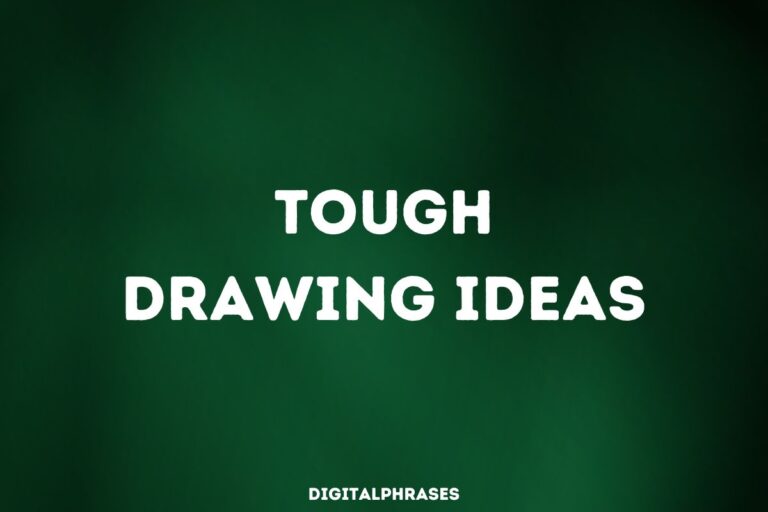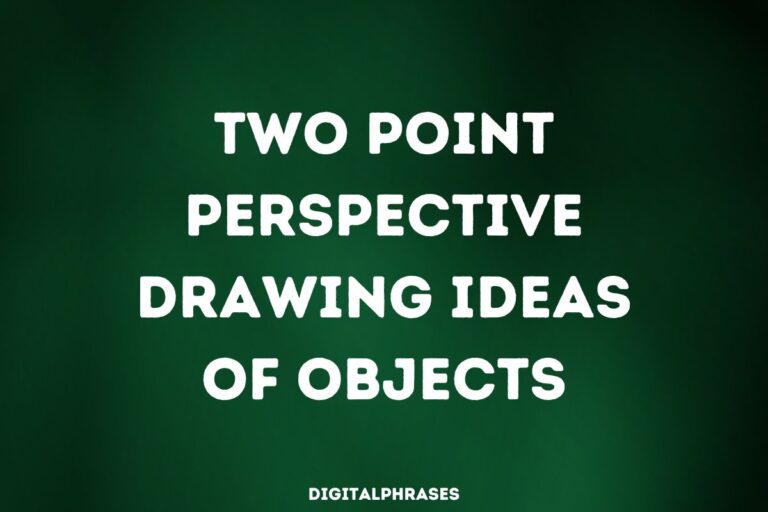40 Drawing Ideas For Teens [Includes Easy, Cute and Creative Ones]
You’re sitting there, minding your own business, when you realize—you need to draw something cute.
Like, right now.
Your soul is practically screaming for some adorable doodle therapy.
Maybe you want to jazz up your notebook or post that one perfect sketch on your Instagram story (you know, the one that makes people think you casually crank out masterpieces).
But then it hits you.
Your mind is blanker than a test you forgot to study for.
What do you even draw?
Don’t panic—I’ve been there, frozen in front of a sketchbook, with nothing but a pencil and pure confusion. But don’t worry, I’ve got your back!
I’ve rounded up some ridiculously easy and super cute drawing ideas perfect for teens (or anyone who just wants to feel artsy without melting their brain).
Ready to turn that creative panic into adorable doodles?
Let’s do this!
Easy Drawing Ideas For Teens
1
![40 Drawing Ideas For Teens [Includes Easy, Cute and Creative Ones] 40 Drawing Ideas For Teens [Includes Easy, Cute and Creative Ones]](https://digitalphrases.com/wp-content/uploads/2024/10/image-edited.png)
2
![40 Drawing Ideas For Teens [Includes Easy, Cute and Creative Ones] 40 Drawing Ideas For Teens [Includes Easy, Cute and Creative Ones]](https://digitalphrases.com/wp-content/uploads/2024/10/image-1.png?v=1729605965)
3
![40 Drawing Ideas For Teens [Includes Easy, Cute and Creative Ones] 40 Drawing Ideas For Teens [Includes Easy, Cute and Creative Ones]](https://digitalphrases.com/wp-content/uploads/2024/10/image-2.png?v=1729605995)
4
![40 Drawing Ideas For Teens [Includes Easy, Cute and Creative Ones] 40 Drawing Ideas For Teens [Includes Easy, Cute and Creative Ones]](https://digitalphrases.com/wp-content/uploads/2024/10/image-3-edited.png)
5
![40 Drawing Ideas For Teens [Includes Easy, Cute and Creative Ones] 40 Drawing Ideas For Teens [Includes Easy, Cute and Creative Ones]](https://digitalphrases.com/wp-content/uploads/2024/10/image-4.png?v=1729606044)
6
![40 Drawing Ideas For Teens [Includes Easy, Cute and Creative Ones] 40 Drawing Ideas For Teens [Includes Easy, Cute and Creative Ones]](https://digitalphrases.com/wp-content/uploads/2024/10/image-5.png?v=1729606048)
7
![40 Drawing Ideas For Teens [Includes Easy, Cute and Creative Ones] 40 Drawing Ideas For Teens [Includes Easy, Cute and Creative Ones]](https://digitalphrases.com/wp-content/uploads/2024/10/image-6.png?v=1729606078)
8
![40 Drawing Ideas For Teens [Includes Easy, Cute and Creative Ones] 40 Drawing Ideas For Teens [Includes Easy, Cute and Creative Ones]](https://digitalphrases.com/wp-content/uploads/2024/10/image-7.png?v=1729606084)
9
![40 Drawing Ideas For Teens [Includes Easy, Cute and Creative Ones] 40 Drawing Ideas For Teens [Includes Easy, Cute and Creative Ones]](https://digitalphrases.com/wp-content/uploads/2024/10/image-8.png?v=1729606086)
10
![40 Drawing Ideas For Teens [Includes Easy, Cute and Creative Ones] 40 Drawing Ideas For Teens [Includes Easy, Cute and Creative Ones]](https://digitalphrases.com/wp-content/uploads/2024/10/image-9.png?v=1729606114)
11
![40 Drawing Ideas For Teens [Includes Easy, Cute and Creative Ones] 40 Drawing Ideas For Teens [Includes Easy, Cute and Creative Ones]](https://digitalphrases.com/wp-content/uploads/2024/10/image-10.png?v=1729606120)
12
![40 Drawing Ideas For Teens [Includes Easy, Cute and Creative Ones] 40 Drawing Ideas For Teens [Includes Easy, Cute and Creative Ones]](https://digitalphrases.com/wp-content/uploads/2024/10/image-11.png?v=1729606125)
13
![40 Drawing Ideas For Teens [Includes Easy, Cute and Creative Ones] 40 Drawing Ideas For Teens [Includes Easy, Cute and Creative Ones]](https://digitalphrases.com/wp-content/uploads/2024/10/image-12.png?v=1729606163)
14
![40 Drawing Ideas For Teens [Includes Easy, Cute and Creative Ones] 40 Drawing Ideas For Teens [Includes Easy, Cute and Creative Ones]](https://digitalphrases.com/wp-content/uploads/2024/10/image-13.png?v=1729606267)
15
![40 Drawing Ideas For Teens [Includes Easy, Cute and Creative Ones] 40 Drawing Ideas For Teens [Includes Easy, Cute and Creative Ones]](https://digitalphrases.com/wp-content/uploads/2024/10/image-14.png?v=1729606275)
16
![40 Drawing Ideas For Teens [Includes Easy, Cute and Creative Ones] 40 Drawing Ideas For Teens [Includes Easy, Cute and Creative Ones]](https://digitalphrases.com/wp-content/uploads/2024/10/image-15.png?v=1729606308)
17
![40 Drawing Ideas For Teens [Includes Easy, Cute and Creative Ones] 40 Drawing Ideas For Teens [Includes Easy, Cute and Creative Ones]](https://digitalphrases.com/wp-content/uploads/2024/10/image-16.png?v=1729606380)
18
![40 Drawing Ideas For Teens [Includes Easy, Cute and Creative Ones] 40 Drawing Ideas For Teens [Includes Easy, Cute and Creative Ones]](https://digitalphrases.com/wp-content/uploads/2024/10/image-17-edited.png)
19
![40 Drawing Ideas For Teens [Includes Easy, Cute and Creative Ones] 40 Drawing Ideas For Teens [Includes Easy, Cute and Creative Ones]](https://digitalphrases.com/wp-content/uploads/2024/10/image-18.png?v=1729606479)
20
![40 Drawing Ideas For Teens [Includes Easy, Cute and Creative Ones] 40 Drawing Ideas For Teens [Includes Easy, Cute and Creative Ones]](https://digitalphrases.com/wp-content/uploads/2024/10/image-19.png?v=1729606505)
Cute and Creative Drawing Ideas For Teens
1
![40 Drawing Ideas For Teens [Includes Easy, Cute and Creative Ones] 40 Drawing Ideas For Teens [Includes Easy, Cute and Creative Ones]](https://digitalphrases.com/wp-content/uploads/2024/10/image-20.png?v=1729606565)
2
![40 Drawing Ideas For Teens [Includes Easy, Cute and Creative Ones] 40 Drawing Ideas For Teens [Includes Easy, Cute and Creative Ones]](https://digitalphrases.com/wp-content/uploads/2024/10/image-21.png?v=1729606739)
3
![40 Drawing Ideas For Teens [Includes Easy, Cute and Creative Ones] 40 Drawing Ideas For Teens [Includes Easy, Cute and Creative Ones]](https://digitalphrases.com/wp-content/uploads/2024/10/image-22.png?v=1729606849)
4
![40 Drawing Ideas For Teens [Includes Easy, Cute and Creative Ones] 40 Drawing Ideas For Teens [Includes Easy, Cute and Creative Ones]](https://digitalphrases.com/wp-content/uploads/2024/10/image-23.png?v=1729606875)
5
![40 Drawing Ideas For Teens [Includes Easy, Cute and Creative Ones] 40 Drawing Ideas For Teens [Includes Easy, Cute and Creative Ones]](https://digitalphrases.com/wp-content/uploads/2024/10/image-24.png?v=1729606886)
6
![40 Drawing Ideas For Teens [Includes Easy, Cute and Creative Ones] 40 Drawing Ideas For Teens [Includes Easy, Cute and Creative Ones]](https://digitalphrases.com/wp-content/uploads/2024/10/image-25.png?v=1729606932)
7
![40 Drawing Ideas For Teens [Includes Easy, Cute and Creative Ones] 40 Drawing Ideas For Teens [Includes Easy, Cute and Creative Ones]](https://digitalphrases.com/wp-content/uploads/2024/10/image-26.png?v=1729607012)
8
![40 Drawing Ideas For Teens [Includes Easy, Cute and Creative Ones] 40 Drawing Ideas For Teens [Includes Easy, Cute and Creative Ones]](https://digitalphrases.com/wp-content/uploads/2024/10/image-27.png?v=1729607016)
9
![40 Drawing Ideas For Teens [Includes Easy, Cute and Creative Ones] 40 Drawing Ideas For Teens [Includes Easy, Cute and Creative Ones]](https://digitalphrases.com/wp-content/uploads/2024/10/image-28.png?v=1729607022)
10
![40 Drawing Ideas For Teens [Includes Easy, Cute and Creative Ones] 40 Drawing Ideas For Teens [Includes Easy, Cute and Creative Ones]](https://digitalphrases.com/wp-content/uploads/2024/10/image-29.png?v=1729607028)
11
![40 Drawing Ideas For Teens [Includes Easy, Cute and Creative Ones] 40 Drawing Ideas For Teens [Includes Easy, Cute and Creative Ones]](https://digitalphrases.com/wp-content/uploads/2024/10/image-30.png?v=1729607082)
12
![40 Drawing Ideas For Teens [Includes Easy, Cute and Creative Ones] 40 Drawing Ideas For Teens [Includes Easy, Cute and Creative Ones]](https://digitalphrases.com/wp-content/uploads/2024/10/image-32.png?v=1729607168)
13
![40 Drawing Ideas For Teens [Includes Easy, Cute and Creative Ones] 40 Drawing Ideas For Teens [Includes Easy, Cute and Creative Ones]](https://digitalphrases.com/wp-content/uploads/2024/10/image-33.png?v=1729607252)
14
![40 Drawing Ideas For Teens [Includes Easy, Cute and Creative Ones] 40 Drawing Ideas For Teens [Includes Easy, Cute and Creative Ones]](https://digitalphrases.com/wp-content/uploads/2024/10/image-34.png?v=1729607513)
15
![40 Drawing Ideas For Teens [Includes Easy, Cute and Creative Ones] 40 Drawing Ideas For Teens [Includes Easy, Cute and Creative Ones]](https://digitalphrases.com/wp-content/uploads/2024/10/image-35.png?v=1729607567)
16
![40 Drawing Ideas For Teens [Includes Easy, Cute and Creative Ones] 40 Drawing Ideas For Teens [Includes Easy, Cute and Creative Ones]](https://digitalphrases.com/wp-content/uploads/2024/10/image-37.png?v=1729607610)
17
![40 Drawing Ideas For Teens [Includes Easy, Cute and Creative Ones] 40 Drawing Ideas For Teens [Includes Easy, Cute and Creative Ones]](https://digitalphrases.com/wp-content/uploads/2024/10/image-38.png?v=1729607633)
18
![40 Drawing Ideas For Teens [Includes Easy, Cute and Creative Ones] 40 Drawing Ideas For Teens [Includes Easy, Cute and Creative Ones]](https://digitalphrases.com/wp-content/uploads/2024/10/image-39.png?v=1729607680)
19
![40 Drawing Ideas For Teens [Includes Easy, Cute and Creative Ones] 40 Drawing Ideas For Teens [Includes Easy, Cute and Creative Ones]](https://digitalphrases.com/wp-content/uploads/2024/10/image-40.png?v=1729607724)
20
![40 Drawing Ideas For Teens [Includes Easy, Cute and Creative Ones] 40 Drawing Ideas For Teens [Includes Easy, Cute and Creative Ones]](https://digitalphrases.com/wp-content/uploads/2024/10/image-36.png?v=1729607578)
Things To Keep In Mind While Executing These Drawings
1. Start with Inspiration, but Stay Open to New Ideas
Before jumping into any drawing, it’s important for teens to find inspiration. Sometimes, this inspiration comes from the world around them—nature, people, objects, or even social media.
Teens can take inspiration from art books, online tutorials, or the work of their favorite artists. However, it’s crucial to remember that inspiration doesn’t mean imitation.
Instead of just copying an existing artwork, encourage teens to build on what inspires them. Whether they like a certain style, color palette, or subject matter, they should make it their own.
This way, they can develop their unique artistic voice. It’s also helpful to explore a wide variety of styles—realism, abstract, anime, or comic art—before settling into a preferred one.
2. Tools Matter, But You Don’t Need the Most Expensive Ones
Teens often feel pressured to buy high-end art supplies because they think it will improve their art instantly.
While professional tools can make a difference in certain technical aspects, the truth is that great art can be made with basic supplies.
Pencils, erasers, sketchpads, and markers from any local store can work perfectly for teens learning to draw. For digital art, free or budget-friendly programs such as Krita, MediBang, or GIMP offer excellent features.
Remember, technique and creativity are far more important than having the most expensive pens, tablets, or brushes.
Once a teen is comfortable with basic tools, they can experiment with more specialized materials, such as charcoal, watercolors, or digital drawing tablets.
Learning to adapt to different tools will only strengthen their artistic abilities.
3. Focus on Technique and Skill-Building
While creative expression is a core part of drawing, learning and practicing techniques is essential for improving over time.
Encourage teens to take the time to understand the fundamentals of drawing, such as proportions, shading, perspective, and composition.
- Proportions: Understanding how different parts of a subject relate to one another (whether it’s a human figure, animal, or object) helps create balanced, accurate drawings.
- Shading: Learning how to properly shade objects gives drawings depth and dimension. Experiment with different shading techniques like hatching, cross-hatching, stippling, and blending.
- Perspective: Perspective drawing helps teens depict three-dimensional objects on a two-dimensional surface. Learning one-point, two-point, and three-point perspective opens up a whole new world of possibilities for landscapes, cityscapes, and architectural drawings.
- Composition: This refers to how different elements in a drawing are arranged. Teens should consider what they want their main focus to be and how other elements complement it.
It’s often useful to dedicate time specifically to skill-building exercises. Practicing basic shapes, studying anatomy, or sketching real-life objects can feel tedious but pays off in the long run.
Progress takes time, and understanding these techniques will greatly enhance the overall quality of their work.
4. Embrace Imperfection and Practice Patience
One of the most valuable lessons for any teen artist is learning to embrace imperfection. Drawing can sometimes lead to frustration, especially when things don’t turn out the way we imagine.
However, mistakes are an essential part of the creative process.
Instead of crumpling up sketches or giving up when things go wrong, teens should see mistakes as learning opportunities.
Patience is crucial in drawing. Not every piece of art will be perfect, and not every sketch will turn out how it was envisioned. Some drawings might take hours, days, or even weeks to complete. Encourage teens to take their time and enjoy the process, rather than focusing solely on the outcome.
Over time, the more they draw, the more confident they’ll become in their abilities. Regular practice will also lead to natural improvements, even if those improvements aren’t immediately noticeable.
5. Experiment with Styles and Mediums
Encourage teens to step out of their comfort zones by trying new styles and mediums. It’s easy to stick to what feels safe and familiar, but trying different techniques will expand their skills and creativity. For example:
- Switch between traditional and digital art: If a teen typically works with pencil and paper, they could try digital drawing or vice versa. Digital art allows for easy undoing of mistakes, while traditional media provides a tactile, hands-on experience.
- Try different styles: Even if a teen loves realistic drawing, they might find inspiration by dabbling in abstract art, surrealism, or minimalism. Trying different styles helps broaden their artistic horizons and might even lead to unexpected breakthroughs.
- Work with color: If they usually stick to black-and-white sketches, encourage them to add color using colored pencils, markers, or paints. Playing with color theory and blending can open up new ways of expressing emotions and ideas in their work.
Exploration is a big part of growth, and even if a teen isn’t initially comfortable with a new medium or style, it will ultimately improve their versatility as an artist.
6. Manage Expectations and Avoid Comparison
In the age of social media, it’s easy for teens to compare their work to other artists, which can lead to feelings of inadequacy or self-doubt.
It’s crucial for teens to understand that every artist progresses at their own pace, and comparing oneself to others often leads to frustration.
Remind teens that the polished works they see online are often the result of hours of practice, not just raw talent.
Everyone starts somewhere, and even professional artists had to go through a long learning process. They should focus on their own artistic journey rather than constantly measuring themselves against others.
It’s also helpful to set realistic expectations. Improvement takes time, and mastery of certain techniques may take weeks or even months. Teens should aim for consistent progress, not perfection.
7. Seek Constructive Feedback, but Don’t Depend on It
Constructive criticism is a vital part of improving as an artist, but teens should learn to balance feedback with their own creative instincts.
Encourage them to share their work with trusted friends, family, teachers, or online art communities. Receiving feedback from others can provide valuable insights that help improve their technique.
However, it’s also important for teens to maintain confidence in their artistic vision. Not every piece of advice is relevant or necessary to follow. As they grow, they’ll learn which feedback resonates with their goals and which can be set aside.
Additionally, while social media can be a great platform to share art, it’s important not to base self-worth or artistic value solely on likes or comments. Some drawings may not get much attention but could still be personal favorites.
8. Use Drawing as a Form of Relaxation and Mindfulness
Drawing can be a powerful form of relaxation, allowing teens to unwind, reduce stress, and focus on the present moment. Instead of always focusing on the end result, teens can use drawing as a way to relax and practice mindfulness.
Encourage them to experiment with doodling, drawing mandalas, or free-form abstract designs without worrying about achieving perfection. The act of putting pencil to paper and watching lines form can be a calming, meditative process.
Moreover, drawing can be a great way for teens to express emotions that might be difficult to put into words. Whether they’re feeling excited, anxious, or sad, drawing can serve as an emotional outlet.
9. Build a Routine and Set Goals
While art should remain a source of joy and self-expression, building a routine can help teens stay motivated.
Setting small, achievable goals—such as sketching for 30 minutes each day or completing one detailed drawing per week—can create a sense of accomplishment.
Goal-setting can also help teens track their progress over time. By keeping a sketchbook or digital portfolio, they can look back on their older work and see how far they’ve come. This practice encourages reflection and reinforces the idea that growth happens gradually.
10. Don’t Be Afraid to Take Breaks
Finally, it’s important for teens to know when to take a break. Creative burnout is real, and forcing oneself to draw when feeling uninspired or stressed can be counterproductive. Encourage teens to step away from their art occasionally, whether it’s to recharge, find new inspiration, or simply rest.
Sometimes, a brief break is all that’s needed to come back to a drawing with fresh eyes and renewed energy. Remember, creativity doesn’t have to be constant—it ebbs and flows, and that’s perfectly normal.






